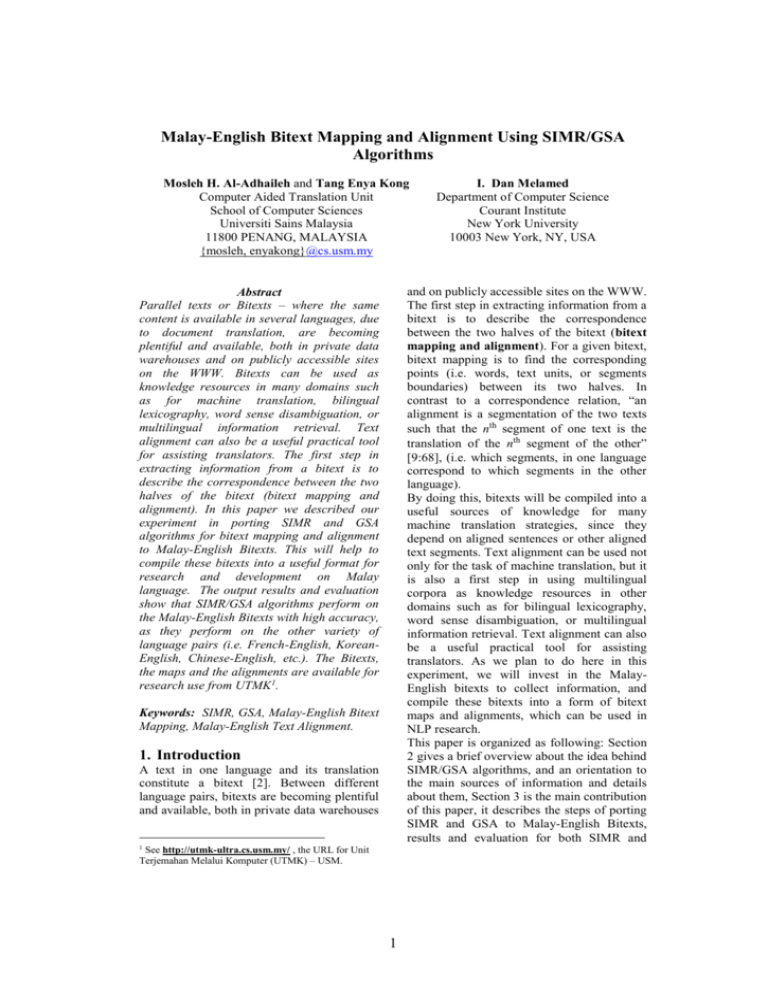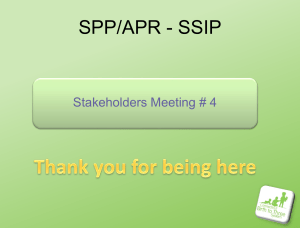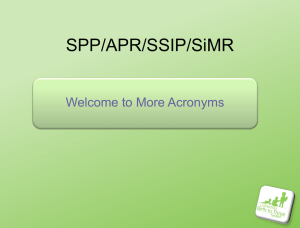Experiment design: - NYU
advertisement

Malay-English Bitext Mapping and Alignment Using SIMR/GSA
Algorithms
Mosleh H. Al-Adhaileh and Tang Enya Kong
Computer Aided Translation Unit
School of Computer Sciences
Universiti Sains Malaysia
11800 PENANG, MALAYSIA
{mosleh, enyakong}@cs.usm.my
I. Dan Melamed
Department of Computer Science
Courant Institute
New York University
10003 New York, NY, USA
and on publicly accessible sites on the WWW.
The first step in extracting information from a
bitext is to describe the correspondence
between the two halves of the bitext (bitext
mapping and alignment). For a given bitext,
bitext mapping is to find the corresponding
points (i.e. words, text units, or segments
boundaries) between its two halves. In
contrast to a correspondence relation, “an
alignment is a segmentation of the two texts
such that the nth segment of one text is the
translation of the nth segment of the other”
[9:68], (i.e. which segments, in one language
correspond to which segments in the other
language).
By doing this, bitexts will be compiled into a
useful sources of knowledge for many
machine translation strategies, since they
depend on aligned sentences or other aligned
text segments. Text alignment can be used not
only for the task of machine translation, but it
is also a first step in using multilingual
corpora as knowledge resources in other
domains such as for bilingual lexicography,
word sense disambiguation, or multilingual
information retrieval. Text alignment can also
be a useful practical tool for assisting
translators. As we plan to do here in this
experiment, we will invest in the MalayEnglish bitexts to collect information, and
compile these bitexts into a form of bitext
maps and alignments, which can be used in
NLP research.
This paper is organized as following: Section
2 gives a brief overview about the idea behind
SIMR/GSA algorithms, and an orientation to
the main sources of information and details
about them, Section 3 is the main contribution
of this paper, it describes the steps of porting
SIMR and GSA to Malay-English Bitexts,
results and evaluation for both SIMR and
Abstract
Parallel texts or Bitexts – where the same
content is available in several languages, due
to document translation, are becoming
plentiful and available, both in private data
warehouses and on publicly accessible sites
on the WWW. Bitexts can be used as
knowledge resources in many domains such
as for machine translation, bilingual
lexicography, word sense disambiguation, or
multilingual information retrieval. Text
alignment can also be a useful practical tool
for assisting translators. The first step in
extracting information from a bitext is to
describe the correspondence between the two
halves of the bitext (bitext mapping and
alignment). In this paper we described our
experiment in porting SIMR and GSA
algorithms for bitext mapping and alignment
to Malay-English Bitexts. This will help to
compile these bitexts into a useful format for
research and development on Malay
language. The output results and evaluation
show that SIMR/GSA algorithms perform on
the Malay-English Bitexts with high accuracy,
as they perform on the other variety of
language pairs (i.e. French-English, KoreanEnglish, Chinese-English, etc.). The Bitexts,
the maps and the alignments are available for
research use from UTMK1.
Keywords: SIMR, GSA, Malay-English Bitext
Mapping, Malay-English Text Alignment.
1. Introduction
A text in one language and its translation
constitute a bitext [2]. Between different
language pairs, bitexts are becoming plentiful
and available, both in private data warehouses
1
See http://utmk-ultra.cs.usm.my/ , the URL for Unit
Terjemahan Melalui Komputer (UTMK) – USM.
1
GSA is detailed in section 4, and Section 5
ends the paper with a brief conclusion.
The GSA algorithm can be applied equally
well to sentences, paragraphs, lists of items,
or any other text units for which boundary
information is available. For more details on
GSA see [7].
2. SIMR and GSA algorithms
A bitext can form the axes of a rectangular
bitext space, as in Figure 1. The height and
width of the rectangle correspond to the
lengths of the two texts, in character. The
lower left corner and the upper right corner of
the rectangle represent the text beginning
(origin) and end (terminus) respectively. The
other corresponding character positions
between the two texts, the true points of
correspondence (TPCs), other than the origin
and the terminus, can be plotted as points in
the bitext space. TPCs exist both at the
coordinates of matching text units and at the
coordinates of matching text units boundaries.
If a token at position x on the x-axis and a
token at position y on the y-axis are
translation of each other, then the coordinate
(x, y) in the bitext space is a TPC. A bitext
map is the real-valued function obtained by
interpolating successive points in a given
bitext space. A complete set of TPCs for a
particular bitext is the true bitext map
(TBM). The purpose of the Smooth Injective
Map Recognizer (SIMR) algorithm is to
produce bitext maps that are the best possible
approximations of each bitext TBM as
illustrated in Figure 2. For more details on
SIMR see [6], and [7].
The Geometric Segment Alignment (GSA)
algorithm reduces sets of correspondence
points in SIMR’s output to segment
alignments. Given a set of correspondence
points, supplemented with segment boundary
information,
expresses
segment
correspondence; segment boundaries form a
grid over the bitext space. Figure 3 illustrates
how segment boundaries form a grid over the
bitext space. Each cell in the grid represents
the intersection of two segments, one from
each half of the bitext. A point of
correspondence inside cell (X,y) indicates that
some token in segment X corresponds with
some token in segment y; i.e., segments X and
y correspond. For example, in Figure 3, the
segment e corresponds with segments G and
H, also the segment f corresponds with the
segment H, so the segment <G, H> should be
aligned with segment <e, f>. In Figure 3 the
aligned blocks are outlined with solid lines.
terminus
Y=
character
position in
text 2
Main
diagonal
origin
x= character position in text 1
Figure 1: A bitext space
Bitext
Malay
English
80
75
70
65
60
55
50
45
40
35
30
25
20
15
10
5
0
0
5 10 15 20 25 30 35 40 45 50 55 60 65 70
SIMR
Bitext Mapping
Malay
English
SIMR
80
75
70
65
60
55
50
45
40
35
30
25
20
15
10
5
0
0
5 10 15 20 25 30 35 40 45 50 55 60 65 70
Figure 2: Bitext mapping using SIMR
3. Porting SIMR/GSA to MalayEnglish Bitext
The report on porting SIMR to a new
language pairs [5] describes the steps that
should be done in order to adapt the SIMR
into a new language pairs. These steps are: ichoosing a match predicate, ii- axis generator
and iii- SIMR’s parameters re-optimization.
In this Experiment, we describe the process
on porting the SIMR on Malay-English bitext.
2
We describe the way we collected our data,
the matching predicate heuristic and the
construction of SIMR’s parameter for MalayEnglish bitext. Results and evaluation of the
SIMR/GSA on the tested data are given in
Section 4. Figure 4 illustrates the process of
porting the SIMR/GSA to Malay-English
bitext.
sentences on y-axis
j
i
h
g
f
e
d
c
b
a
A B C D E F G H I
J K L
sentences on x-axis
Figure 3: Segment boundaries form a grid over the bitext
space. Each cell in the grid represents the intersection of
two segments, one from each half of the bitext. A point of
correspondence inside cell (X, y) indicates that some
token in segment X corresponds with some token in
segment y; i.e., segments X and y correspond. For
example, segment E corresponds with segment d. The
aligned blocks are outlined with solid lines.
Training Data
Manual
Alignment
3.1 Data Collection
The linguistic department at Unit Terjemahan
Melalui Komputer (UTMK) collected some
Malay-English bitexts in different genres
(novels, user guides, literature books, etc.).
The problem is: these bitexts were processed
using a scanner to scan the text first, and then
a tool was used to change them into texts. By
doing this, the bitexts need to be edited, and
most of them are not edited yet, or in process
of editing. Fortunately, we find the two books
“The 7 Habits of Highly Effective People”
[10] and “Semantics” [8] are almost edited.
The “7 Habits” book consisted of 101,790
words in the English version and 107,161
words in the Malay version. It is divided into
13 chapters. From the “Semantics” book we
collected 8 chapters, all together about 50,170
words in the English version, and 51,802
words in the Malay version. Both the “7
Habits” and the “Semantics” books are handaligned at the level of sentences. Also we find
that The “Microsoft Word User Guide” can be
used in our test, but it is raw data, so we took
only the first 20 pages and we hand-aligned
them for the purpose of testing SIMR/GSA.
These bitexts were suitable for our testing at
the beginning stage; the data is specified in
Table 2.
Validate Manual
Alignment
ADOMIT
Parameter
re-optimization
Test Data
Malay
English
Malay
Bitext Mapping
English
Malay
Axis
generator
KIMD
Bilingual
dictionary
Lexicon
SIMR
Segment Alignment
Malay
English
Figure 4: Malay-English bitext mapping and alignment using SIMR/GSA
3
English
GSA
3.2 Matching Predicate
A matching predicate is a heuristic used to
decide whether two given tokens in the bitext
might be mutual translations. The matching
predicate is one of the SIMR’s parameters,
and should be defined before using the SIMR.
The Malay and English languages share the
same alphabet, and orthographic cognates (i.e.
two tokens in the bitext with the same
meaning and similar spellings) exist between
them, but the correspondence points generated
based on cognates are not enough signal for
SIMR to achieve an accurate mapping. In this
case another matching predicate is used to
strengthen the signal by generating more
correspondence points, which is a translation
lexicon. The translation lexicon is a list of
word pairs that are believed to be mutual
translations. This lexicon can be extracted
from a machine-readable bilingual dictionary.
In our case, we have an English-Malay
machine-readable
bilingual
dictionary
“Kamus Inggeris Melayu Dewan (KIMD)”
[1]. It consisted of 42,000 entries. We find
that the KIMD, that we have, has more than
20000 entries, which are single-word to
single-word, also we can use the phrasal
equivalences, which give us a lexicon of
38,343 word pairs. We think this is probably
enough to get good results. The lexicon is
lemmatized in the same way of lemmatizing
the collected bitexts, as we will explain in
Section 3.3. The matching predicates were
fine-tuned with a stop-list words for both
English and Malay languages. The translation
lexicon pairs with the cognates and the
punctuation marks between the two sides of
the bitext should give very good signals to the
SIMR algorithm.
punctuation marks and numbers. The position
of a token (in character) is the position of its
median character. For example, the axis for
the sentence “tujuh tabiat gambaran
seluruh .” looks like this:
3.3 Axis Generator
The next step in porting SIMR/GSA to a new
language pair is axis generating. As
mentioned previously, SIMR takes two bitext
space axis as parameters. The mapping from
tokens to axis position is performed by using
a language-specific axis generator program,
one for each half of the bitext. Tokens should
correspond to the smallest semantic unit of
the language in hand. Usually, such units are
words. Like English tokens, Malay tokens are
separated by space. So a simple
approximation is to assign a position to every
space-delimited token, taking in consideration
3.4 Parameter Optimization
The report on porting SIMR to new language
pairs [5] recommends re-optimization of the
SIMR’s parameters. To optimize the
parameters, a training data should be prepared
and mapped (i.e. Normally, the creation of the
bitext maps is done manually). The training
bitext maps should at least consist of 500
points. For this purpose, since the “7 Habits”
book is manually aligned at the level of
sentences, we took Chapter 3, 7 and 11 as a
training data. This data consists of 1245
segments.
0 <EOS>
3 tujuh
9.5 tabiat
17.5 gambaran
26 seluruh
31 .
31.5 <EOS>
Although SIMR doesn’t care about the
segment boundaries, they are central to the
process that converts SIMR’s bitext maps to
segment alignments, i.e. GSA process.
Therefore, the input axes must carry segment
boundary information in the form of markers,
such as <EOS> in the above example. These
markers must have a text position just like any
other text token.
Data Lemmatization
Before using the bitext, we need to lemmatize
both the English and the Malay versions. For
lemmatizing the English we use Brill’s POS
tagger and the XTAG lexicon, it contains
90000 roots yield over 317000 inflected forms
[3]. The English text is tokenized, and then it
is tagged with a simplified version of the Penn
Tree Bank tag set using Brill’s POS tagger. A
program is used to compute the stem for each
word using the POS tag and the XTAG
lexicon.
For the Malay side, a root construction
program is used to construct the root for every
word in the Malay text (if possible), it based
on rules and a lexicon for the root words in
Malay. The lexicon contains the roots for
10000 popular words in the Malay language.
4
y= character position in text2
Validate the Manual Alignment Before
starting parameters re-optimization; we make
sure that this data is not noisy by checking the
manual alignment using an omission detection
tool ADOMIT [4], because we can’t do
parameter re-optimization on a noisy data.
ADOMIT is an algorithm for Automatic
Detection of OMIssions in Translations. It
relies solely on geometric analysis of bitext
maps and uses no linguistic information. The
basic method of ADOMIT is: Given a noisefree bitext map, firstly, a bitext space is
constructed by placing the original text on the
x-axis, and the translation on the y-axis,
secondly, the known point of correspondence
are plotted in the bitext space. Each adjacent
pair of points delimits a segment of the bitext
map. Any segment whose slope is unusually
low is a likely omission, as illustrated in
Figure 5. For more details about ADOMIT
see[4].
ADOMIT is not used only for omission
detection, but also to detect the errors in handaligned bitexts. It is not surprising to find
errors in hand-aligned bitexts. So before reoptimizing the SIMR’s parameters on the
hand-aligned training data, we validate it
using ADOMIT.
After validating the hand-aligned training
data, and fixing the detected error, reoptimization is done using simulated
annealing [11]. The construct set of the
optimized parameters for the Malay-English
testing bitexts is shown in Table 1.
Parameter
Value
Chain size
7
Max. point ambiguity
6
Max. angle deviation
0.14
Max. linear regression error
5
Min. Cognate length ratio
0.80
Table 1: The optimized set of SIMR’s parameters
based on the Malay-English training bitext.
4. Results and Evaluation
b
a
A
O
B
x= character position in text1
Figure 5: An omission in bitext space. Regions A and B
correspond to regions a and b, respectively. Region O has
no corresponding region on the vertical axis.
5
The evaluation metric, for SIMR results, is
the root mean square distance (RMS), in
character, between each TPC and the
interpolated bitext map produced by SIMR,
where
the
distance
was
measured
perpendicular to the main diagonal. For each
test data, the number of test TPCs were
derived from segment hand-alignments by
pairing the character position at the ends of
aligned pairs. In Table 2, for each test data,
the number of test TPCs is: #of segments – 1.
For the GSA results, the error rate (%) is the
percentage of the wrong segment alignments
(comparing to the hand-aligned test data)
from the total segments in the test data.
Based on the results we noticed:
-Most of the GSA errors happened in case of
omissions in one side, or there should be a
combination of segments in one side. (i.e. 1omitted, 1-n alignments).
- The results of GSA on the “Semantics” book
and the “MS Word User Guide” are very
good. Most of the test data are aligned
correctly as compared to the hand-aligned
data. These surprisingly good results may be a
result of: i- A more literal translation between
the two halves of the bitext. The stronger
signal
can
improve
SIMR’s/GSA’s
performance. ii- The “7 Habits” data might
still be noisy. Table 2 reports SIMR’s and
GSA errors on the test data. The output results
and evaluation have shown that SIMR/GSA
algorithms can map/align Malay-English
bitexts with high accuracy as they performed
on the other variety of language pairs and text
genres. These results encourage us, as a future
work, to think of extending the text alignment
to word alignment aiming at the identification
of correspondence between linguistic units
below the sentence level within a bitext.
[1] Dewan Bahasa dan Pustaka. 1992, Kamus
Inggeris Melayu Dewan, Kuala Lumpur, 1st
edt.
[2] Harris B. 1988. Bi-text, a new concept in
translation theory. Language Monthly, 54: pp
8-10.
[3] Karp D., Schabes Y., Zaidel M. and Egedi
D. 1992. A Freely Available Wide Coverage
Morphological Analyzer for English, In Proc.
of COLING '92. pp 950- 954, Nantes, France.
[4] Melamed I.D. 1996. Automatic detection
of omissions in translations. In Proc. of the
16th International Conference on Computational Linguistic, pp 764-769, Copenhagen,
Denmark.
[5] Melamed I.D. 1996. Porting SIMR to new
language pairs. Institute for research in
Cognitive Science Technical Report 96-26,
University of Pennsylvania, PA.
[6] Melamed I.D. 1997. A portable algorithm
for mapping bitext correspondence. In Proc.
of the 35th Annual Meeting ACL, pp 305-312,
Madrid, Spain.
# of
SIMR
points
RMS
error in
chartacter
for SIMR
Error
rate (%)
for GSA
# of
Segments
References
In this paper we described our experiment in
porting SIMR and GSA algorithms to MalayEnglish bitexts. The output results and
evaluation have shown that SIMR/GSA
algorithms can map/align Malay-English
bitexts with high accuracy as they performed
on the other variety of language pairs and text
genres. SIMR is robust in the face of texts that
are different in genre and structure (i.e.
missing segments or omission, inversion, and
crossing dependencies). These features make
SIMR/GSA algorithms one of the most
widely applicable bitext mapping and
alignment published to date. Also, a word for
researchers who need to do Malay-English
text alignment, SIMR/GSA can be ported to
Malay-English bitexts with minimal efforts.
This experiment will form the base for
researchers to work on bitexts where Malay
language is involved, and more importantly to
consider Malay-English bitext, which are
available, to test and evaluate their
algorithms.
Bitext
5. Conclusion
[7] Melamed I.D. 1999. Bitext maps and
Alignment
via
Pattern
Recognition.
Computational Linguistic, 25, No 1, pp 107130.
The “7 Habits ” book
27
184
12.3
0.0
620
3094
60.7
2.7
581
2391
8.0
6.2
970
4826
9.0
2.6
714
3489
8.3
2.4
670
3403
8.1
1.8
752
2670
8.6
6.9
501
2241
9.2
4.6
212
1007
9.3
1.9
119
840
11.6
4.2
The “ Semantics” book
Chapter 1
136
969
10.7
0.0
Chapter 2
194
1856
10.6
0.0
Chapter 3
346
2768
11.0
0.0
Chapter 4
194
1856
10.7
0.0
Chapter 5
217
1438
10.2
0.0
Chapter 6
237
1897
10.0
0.0
Chapter 7
318
2218
12.3
0.0
Chapter 8
132
1039
18.6
1.5
Microsoft word User Guide
The first 20
400
3233
7.6
0.5
pages
Table 2: RMS errors in character s for SIMR results,
and the Error rate % for the GSA results on the
tested bitexts.
Chapter 1
Chapter 2
Chapter 4
Chapter 5
Chapter 6
Chapter 8
Chapter 9
Chapter 10
Chapter 12
Chapter 13
[8] Palmer F.R. 1981. Semantics, Cambridge
University Press.
[9] Simard M., Foster G. and Isabelle P. 1992.
Using Cognates to align sentences in
bilingual corpora. In Proc. of the 4th
International Conference on Theoretical and
Methodological
Issues
in
Machine
Translation, pp 67-81, Montreal, Canada.
[10] Stephen R.C. 1990. The 7 habits of
highly effective people, Published by Simon &
Schuster, 1st edt.
[11] Vidal R.V. editor. 1993. Applied
Simulated
Annealing.
Springer-Verlag,
Heidelberg, Germany.
6









